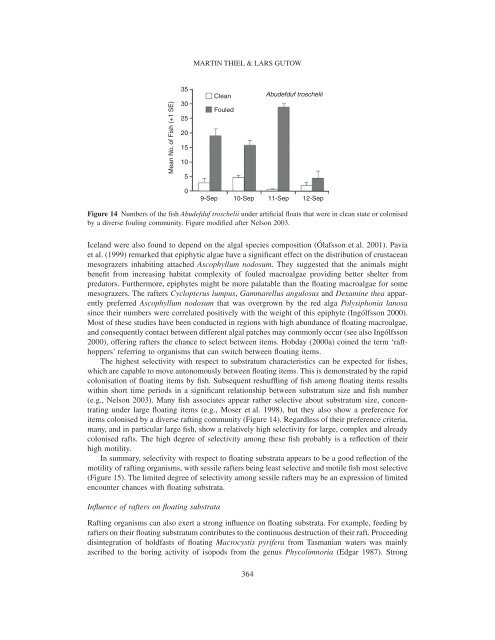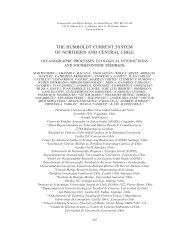The ecology of rafting in the marine environment - Bedim
The ecology of rafting in the marine environment - Bedim
The ecology of rafting in the marine environment - Bedim
Create successful ePaper yourself
Turn your PDF publications into a flip-book with our unique Google optimized e-Paper software.
Mean No. <strong>of</strong> Fish (+1 SE)<br />
35<br />
30<br />
25<br />
20<br />
15<br />
10<br />
MARTIN THIEL & LARS GUTOW<br />
Figure 14 Numbers <strong>of</strong> <strong>the</strong> fish Abudefduf troschelii under artificial floats that were <strong>in</strong> clean state or colonised<br />
by a diverse foul<strong>in</strong>g community. Figure modified after Nelson 2003.<br />
Iceland were also found to depend on <strong>the</strong> algal species composition (Ólafsson et al. 2001). Pavia<br />
et al. (1999) remarked that epiphytic algae have a significant effect on <strong>the</strong> distribution <strong>of</strong> crustacean<br />
mesograzers <strong>in</strong>habit<strong>in</strong>g attached Ascophyllum nodosum. <strong>The</strong>y suggested that <strong>the</strong> animals might<br />
benefit from <strong>in</strong>creas<strong>in</strong>g habitat complexity <strong>of</strong> fouled macroalgae provid<strong>in</strong>g better shelter from<br />
predators. Fur<strong>the</strong>rmore, epiphytes might be more palatable than <strong>the</strong> float<strong>in</strong>g macroalgae for some<br />
mesograzers. <strong>The</strong> rafters Cyclopterus lumpus, Gammarellus angulosus and Dexam<strong>in</strong>e <strong>the</strong>a apparently<br />
preferred Ascophyllum nodosum that was overgrown by <strong>the</strong> red alga Polysiphonia lanosa<br />
s<strong>in</strong>ce <strong>the</strong>ir numbers were correlated positively with <strong>the</strong> weight <strong>of</strong> this epiphyte (Ingólfsson 2000).<br />
Most <strong>of</strong> <strong>the</strong>se studies have been conducted <strong>in</strong> regions with high abundance <strong>of</strong> float<strong>in</strong>g macroalgae,<br />
and consequently contact between different algal patches may commonly occur (see also Ingólfsson<br />
2000), <strong>of</strong>fer<strong>in</strong>g rafters <strong>the</strong> chance to select between items. Hobday (2000a) co<strong>in</strong>ed <strong>the</strong> term ‘rafthoppers’<br />
referr<strong>in</strong>g to organisms that can switch between float<strong>in</strong>g items.<br />
<strong>The</strong> highest selectivity with respect to substratum characteristics can be expected for fishes,<br />
which are capable to move autonomously between float<strong>in</strong>g items. This is demonstrated by <strong>the</strong> rapid<br />
colonisation <strong>of</strong> float<strong>in</strong>g items by fish. Subsequent reshuffl<strong>in</strong>g <strong>of</strong> fish among float<strong>in</strong>g items results<br />
with<strong>in</strong> short time periods <strong>in</strong> a significant relationship between substratum size and fish number<br />
(e.g., Nelson 2003). Many fish associates appear ra<strong>the</strong>r selective about substratum size, concentrat<strong>in</strong>g<br />
under large float<strong>in</strong>g items (e.g., Moser et al. 1998), but <strong>the</strong>y also show a preference for<br />
items colonised by a diverse <strong>raft<strong>in</strong>g</strong> community (Figure 14). Regardless <strong>of</strong> <strong>the</strong>ir preference criteria,<br />
many, and <strong>in</strong> particular large fish, show a relatively high selectivity for large, complex and already<br />
colonised rafts. <strong>The</strong> high degree <strong>of</strong> selectivity among <strong>the</strong>se fish probably is a reflection <strong>of</strong> <strong>the</strong>ir<br />
high motility.<br />
In summary, selectivity with respect to float<strong>in</strong>g substrata appears to be a good reflection <strong>of</strong> <strong>the</strong><br />
motility <strong>of</strong> <strong>raft<strong>in</strong>g</strong> organisms, with sessile rafters be<strong>in</strong>g least selective and motile fish most selective<br />
(Figure 15). <strong>The</strong> limited degree <strong>of</strong> selectivity among sessile rafters may be an expression <strong>of</strong> limited<br />
encounter chances with float<strong>in</strong>g substrata.<br />
Influence <strong>of</strong> rafters on float<strong>in</strong>g substrata<br />
5<br />
0<br />
Clean<br />
Fouled<br />
9-Sep 10-Sep 11-Sep 12-Sep<br />
Raft<strong>in</strong>g organisms can also exert a strong <strong>in</strong>fluence on float<strong>in</strong>g substrata. For example, feed<strong>in</strong>g by<br />
rafters on <strong>the</strong>ir float<strong>in</strong>g substratum contributes to <strong>the</strong> cont<strong>in</strong>uous destruction <strong>of</strong> <strong>the</strong>ir raft. Proceed<strong>in</strong>g<br />
dis<strong>in</strong>tegration <strong>of</strong> holdfasts <strong>of</strong> float<strong>in</strong>g Macrocystis pyrifera from Tasmanian waters was ma<strong>in</strong>ly<br />
ascribed to <strong>the</strong> bor<strong>in</strong>g activity <strong>of</strong> isopods from <strong>the</strong> genus Phycolimnoria (Edgar 1987). Strong<br />
364<br />
Abudefduf troschelii










